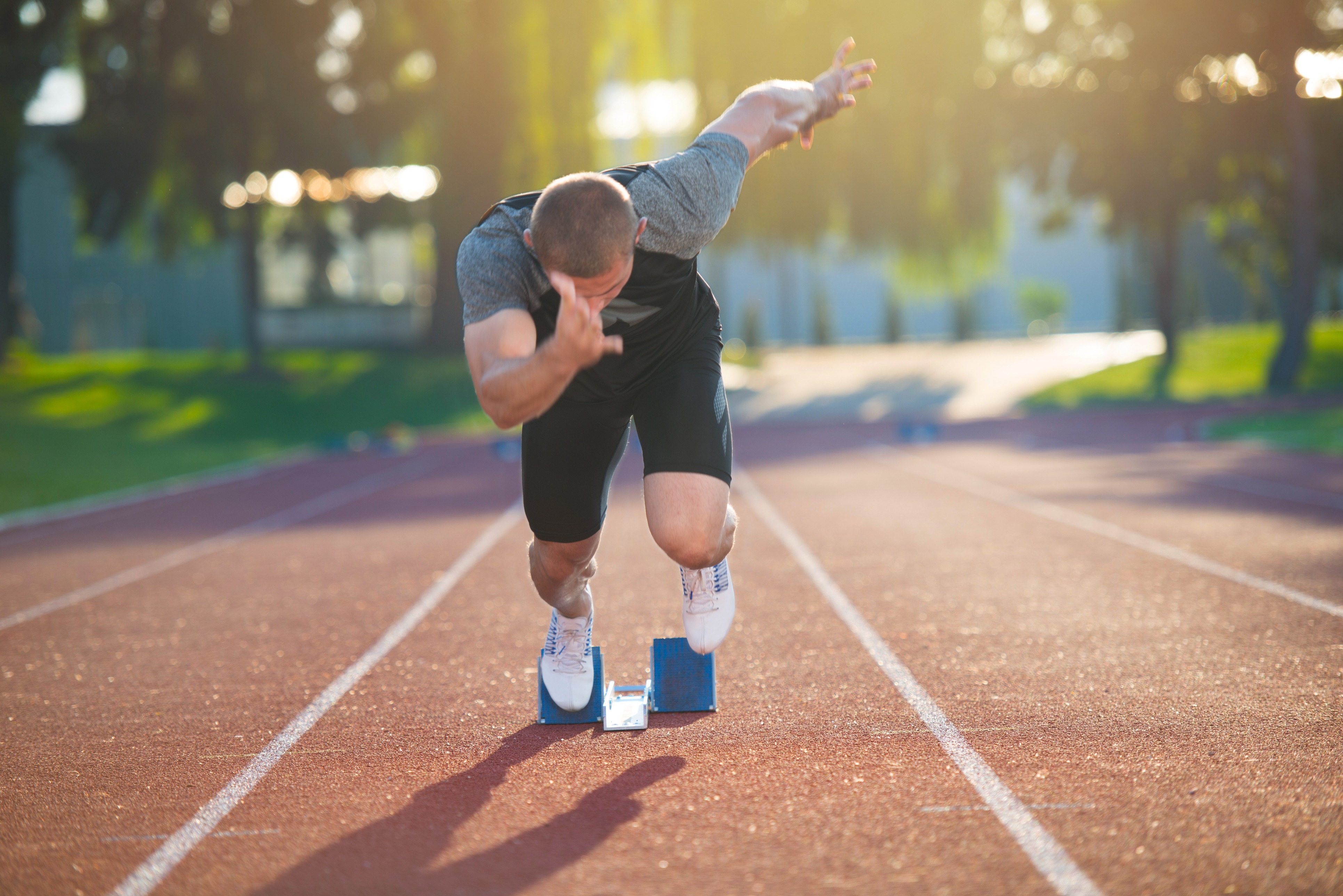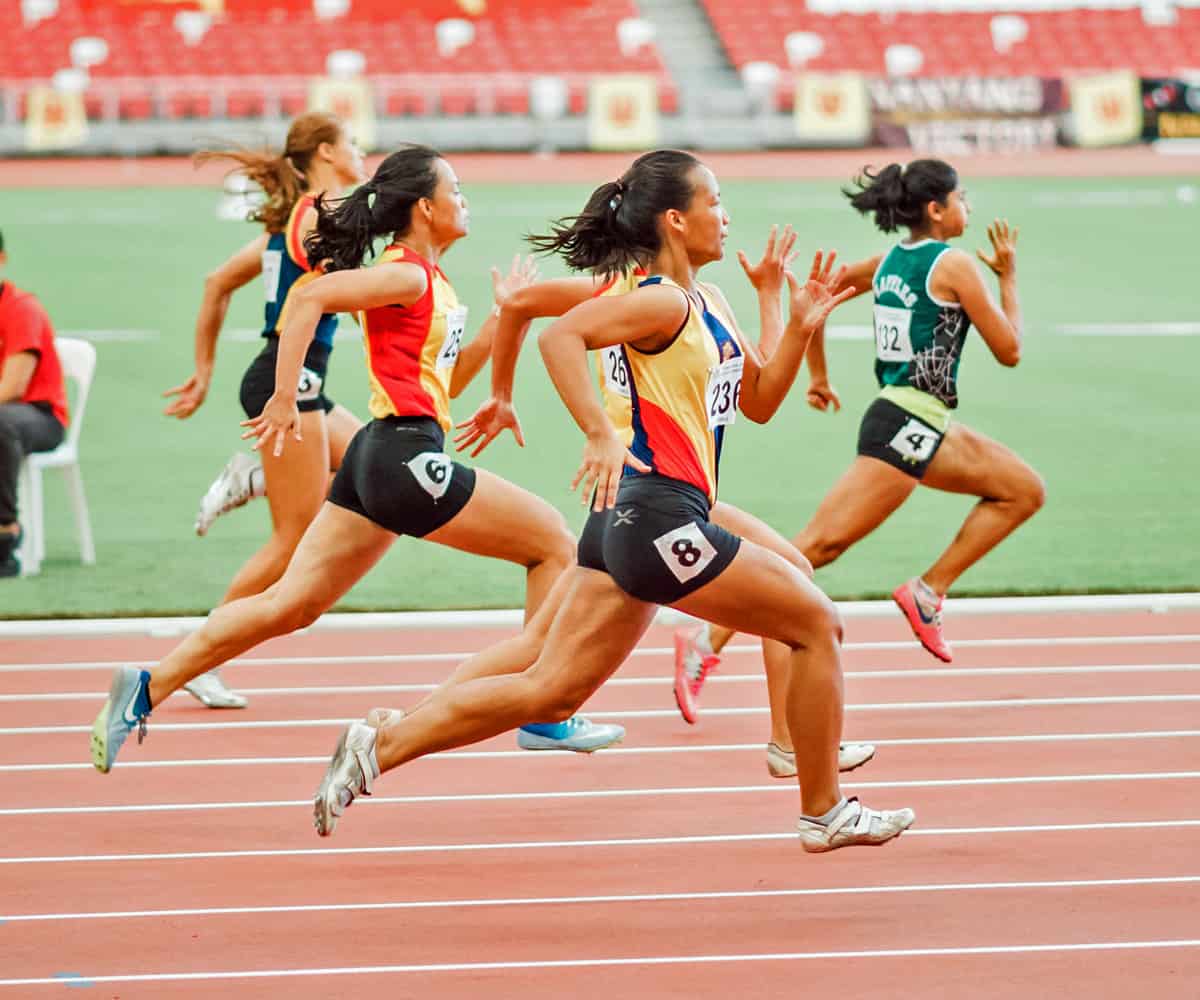An Introduction to Sprint Speed in Athletics
Understanding and improving sprint speed in athletics is pivotal for athletes aiming to elevate their performance. Sprint speed, a critical component in numerous sports, can be the deciding factor between victory and defeat. It is the explosive burst of pace that sets apart the elite from the average, such as the sprint speed demonstrated by world-renowned athletes like Usain Bolt or Florence Griffith-Joyner.
Sprint speed is more than just running fast. It is a complex combination of muscle power, technique, and mental resilience. The ability to attain high velocity in a short span time, maintain it, and repeat it as needed is what defines sprint speed. It is an attribute that can be measured in various ways, including split times, finish times, or even through advanced technology like laser systems and wearable devices.
While genetics and natural talent play a part in determining an athlete’s sprint speed, it is the continuous effort to improve and refine this attribute that truly makes a difference. The field of athletics has seen many instances where hard work, determination, and the right training methods have helped athletes surpass their perceived limits and achieve remarkable feats in sprint speed.
In the journey to improve sprint speed, it is vital to grasp the fundamentals. The factors influencing sprint speed are numerous, ranging from an athlete’s form and technique to strength and conditioning routines, dietary habits, and rest patterns. Understanding these factors can provide a robust foundation on which athletes can build their training programs.

A strategic approach towards improving sprint speed in athletics involves a blend of theory and practice. It requires athletes to learn the science behind sprinting, apply this knowledge through targeted exercises and drills, and continuously monitor and adjust their performance based on feedback and results.
However, one must not overlook the significance of mental preparation. The mindset of a sprinter can profoundly influence their performance. Cultivating a positive mindset, setting realistic goals, and staying motivated even in the face of challenges are aspects that athletes should focus on.
Innovative technologies are also playing an increasingly important role in helping athletes improve their sprint speed. Wearable devices that provide real-time feedback, advanced training equipment, and data analytics are some of the tools that athletes can leverage to gain an edge.
This article strives to be a comprehensive guide for athletes seeking to improve their sprint speed. It provides insights into the fundamentals of sprint speed, effective strategies for improvement, common pitfalls to avoid, and inspiring success stories. It encourages athletes to embark on their journey towards improving sprint speed with a holistic view, understanding that it is a continuous process that requires dedication, discipline, and a willingness to learn.
Understanding the Fundamentals of Sprint Speed
When it comes to improving sprint speed in athletics, a fundamental understanding of the underlying principles is paramount. Sprint speed, the pinnacle of athletic performance, is a blend of various elements, each contributing to how quick an athlete can cover a set distance.
Sprint speed is primarily dictated by two factors: stride length and stride frequency. Stride length refers to the distance covered in one stride, while stride frequency is the rate at which these strides are taken. An optimal balance between these two factors results in superior sprint speed.
However, achieving this balance is not a straightforward task. It requires an in-depth understanding of biomechanics – the study of the structure and function of biological systems. Biomechanics in sprinting involves analyzing how the body moves, how muscles work together, and how force is applied and transferred through the body.

One of the key aspects of sprinting biomechanics is the ‘ground reaction force’ – the force exerted by the ground on a body in contact with it. In sprinting, athletes must utilize this force effectively to propel themselves forward. The manner in which the foot strikes the ground, the angle of the body, and the pulling and pushing actions of the arms and legs all play a vital role in managing this force.
Another pivotal element is the energy system used during sprinting. Unlike endurance running, which primarily uses aerobic energy systems, sprinting relies on anaerobic energy systems. Understanding this can help athletes design training programs that specifically target and enhance these energy systems.
While these principles lay the foundation for understanding sprint speed, the field of athletics is rapidly evolving. Innovative technologies, advancements in sports science, and new training methodologies continually redefine our understanding of sprinting. For instance, motion capture technology and data analytics provide detailed insights into an athlete’s performance, revealing areas for improvement that were previously undetectable.
In essence, understanding the fundamentals of sprint speed is a dynamic process, requiring athletes to stay updated with the latest trends and advancements. It involves a continuous learning process, where athletes integrate theoretical knowledge with practical training to optimize their performance.
With a solid grasp of these fundamentals, athletes can set realistic goals, make informed decisions about their training, and monitor their progress more effectively. It also allows them to understand the limitations and potential risks associated with sprinting, enabling them to train smarter and safer.
This journey towards improving sprint speed is not just about running faster. It’s about understanding the mechanics of movement, harnessing the power within, and constantly striving for improvement.
Ways to Improve Sprint Speed in Athletics
Improving sprint speed in athletics is a multifaceted process that requires a combination of physical training, technical refinement, and mental conditioning. Here are some strategies that athletes can employ to enhance their sprint speed.
Strength and Power Training: Sprinting is a power-intensive activity. Therefore, strength and power training form the cornerstone of any sprint speed improvement program. Exercises like squats, lunges, and plyometrics can help develop the lower body strength necessary for powerful strides.
Technique Refinement: The efficiency of an athlete’s sprinting technique can significantly influence their speed. Athletes should focus on improving their running form, stride length, and stride frequency. This can be achieved through drills that emphasize proper foot strike, optimal body lean, and efficient arm swing.
Speed Endurance Training: While raw speed is important, the ability to maintain that speed over the duration of the sprint is equally crucial. High-intensity interval training (HIIT) can help improve an athlete’s speed endurance.
Flexibility and Mobility Exercises: Greater flexibility and mobility can lead to a more efficient running form, thereby improving sprint speed. Regular stretching and mobility exercises should be an integral part of an athlete’s training routine.
Nutrition and Recovery: Proper nutrition and adequate recovery are essential for optimal athletic performance. Athletes should ensure they are consuming a balanced diet and getting enough rest to allow their bodies to recover and adapt to the training stimulus.
/athlete-performing-in-green-sportsarena-526406551-32633628a55c4eec973e449023305685.jpg)
Mental Conditioning: The mental aspect of sprinting is often overlooked. However, mental conditioning, including goal setting, visualization, and maintaining a positive mindset, can have a significant impact on an athlete’s performance.
Leveraging Technology: Modern technology offers a range of tools that athletes can use to improve their sprint speed. From wearable devices that provide real-time performance feedback to software that analyzes an athlete’s technique, technology can be a valuable ally in the quest for speed.
While these strategies can help improve sprint speed, it’s important to remember that progress takes time. Consistency, patience, and a willingness to learn are key. Athletes should also consider working with a coach or trainer who can provide personalized guidance based on their individual needs and goals.
In the next section, we will delve deeper into how to implement a sprint speed training program, providing a step-by-step guide to help athletes on their journey towards improving sprint speed in athletics.
How to Implement a Sprint Speed Training Program
Implementing a sprint speed training program requires a systematic approach that encompasses various factors to optimize an athlete’s performance. Here’s a step-by-step guide to help athletes design an effective training program to enhance their sprint speed in athletics.
Assessment and Goal Setting: The first step is to conduct a thorough assessment of the athlete’s current sprinting abilities. This may involve analyzing sprint times, biomechanics, and strength levels. Based on the assessment, specific and measurable goals should be set to track progress throughout the training program.
Periodization: Developing a periodized training plan is essential to ensure that the athlete progresses systematically. This involves dividing the training program into distinct phases, each focusing on different aspects such as building a strength base, improving speed endurance, and tapering for peak performance.
Training Modalities: The training program should incorporate a variety of modalities to target different aspects of sprint speed. This may include resistance training, plyometrics, sprint drills, and speed endurance workouts. Each modality should be strategically integrated to address specific components of sprint speed.
Duration, Frequency, and Intensity: The duration, frequency, and intensity of training sessions are critical factors in a sprint speed training program. Balancing these variables is essential to prevent overtraining and optimize performance gains. A mix of high-intensity sessions and adequate recovery periods is key.
Technical Coaching: Working with a qualified coach who specializes in sprinting can provide invaluable technical guidance. Coaches can offer feedback on running form, stride mechanics, and race strategies, helping athletes refine their technique for optimal sprint speed.
Nutrition and Recovery: Proper nutrition and recovery play a vital role in the effectiveness of a training program. Athletes should ensure they are consuming a well-balanced diet to support their training and allowing adequate time for rest and recovery to optimize performance gains.

Monitoring and Adjustments: Regular monitoring of progress is crucial to track the effectiveness of the training program. This may involve conducting regular performance assessments, analyzing training data, and making necessary adjustments to the program based on the athlete’s response to training.
Mental Preparation: Mental preparation is often overlooked but is a crucial aspect of sprint speed training. Athletes should focus on mental conditioning, visualization techniques, and goal setting to enhance their mental resilience and focus during training and competition.
By following these steps and tailoring the training program to individual needs, athletes can effectively enhance their sprint speed and overall athletic performance. It’s important to approach the training program with dedication, consistency, and a willingness to adapt based on feedback and results.
Real Stories of Improvements in Sprint Speed
Real-life stories and case studies of athletes who have successfully improved their sprint speed serve as powerful sources of inspiration and practical examples for readers. These stories not only demonstrate the potential for improvement but also provide valuable insights into the strategies and dedication required to achieve significant progress in sprint speed.
One such remarkable story is that of Pippo, who, through unwavering determination and a meticulously designed training program, managed to enhance their sprint speed. This achievement was the result of a holistic approach that encompassed various aspects, including strength training, technical refinement, and mental conditioning.

Another inspiring case study involves Pluto, whose journey to improve sprint speed is a testament to the transformative power of consistent effort and perseverance. By incorporating innovative training methodologies and leveraging cutting-edge technology, Pluto was able to achieve a remarkable breakthrough in their sprint speed, surpassing their previous limitations and setting new personal records.
These real stories not only highlight the potential for improvement but also shed light on the challenges and setbacks that athletes may encounter along the way. They provide valuable lessons on resilience, adaptability, and the importance of seeking continuous improvement.
Furthermore, these stories emphasize the significance of personalized training programs tailored to individual strengths, weaknesses, and goals. They underscore the impact of strategic planning, consistent execution, and the unwavering belief in one’s ability to achieve significant improvements in sprint speed.
By sharing these real-life examples, this article aims to inspire and motivate readers to embark on their own journey towards improving sprint speed. It reinforces the idea that while the path to improvement may present challenges, dedication, perseverance, and the right techniques can lead to remarkable results.
In the next section, we will explore the common pitfalls that athletes should be mindful of when striving to improve their sprint speed, providing valuable advice on how to avoid these pitfalls and stay on track towards achieving their goals.
Common Pitfalls in Improving Sprint Speed
Improving sprint speed is a challenging endeavor that requires a strategic and disciplined approach. However, there are common pitfalls that athletes should be mindful of when striving to enhance their sprint speed. By understanding these pitfalls and learning how to avoid them, athletes can optimize their training and progress more effectively.
Overtraining: One of the most prevalent pitfalls in sprint speed improvement is overtraining. Pushing the body beyond its limits without adequate rest and recovery can lead to fatigue, increased risk of injury, and diminished performance. It’s essential for athletes to strike a balance between training intensity and recovery to avoid overtraining.
Neglecting Strength Training: While sprinting is primarily about speed, neglecting strength training can hinder overall performance. Building lower body strength is crucial for generating powerful strides and maintaining speed over the duration of a sprint. Athletes should incorporate strength training exercises to complement their sprint-specific training.
Poor Running Form: Inadequate running form can significantly impede sprint speed improvement. Factors such as improper foot strike, excessive upper body movement, and inefficient arm swing can compromise speed and efficiency. Athletes should focus on refining their running technique to optimize sprint speed.
Lack of Periodization: Failing to implement a periodized training plan can hinder progress. Periodization involves structuring training into distinct phases to target different aspects of sprint speed, such as strength development, speed endurance, and tapering for peak performance. Without proper periodization, athletes may struggle to achieve optimal results.
Inadequate Recovery and Nutrition: Insufficient attention to recovery and nutrition can undermine training efforts. Proper nutrition and adequate rest are essential for muscle recovery, energy replenishment, and overall performance. Athletes should prioritize recovery strategies and maintain a well-balanced diet to support their training.

Mental Barriers: Mental barriers, such as self-doubt and negative mindset, can hinder sprint speed improvement. Overcoming mental barriers and cultivating a positive mindset are crucial for achieving peak performance. Athletes should focus on mental conditioning and visualization techniques to enhance their mental resilience.
By recognizing and addressing these common pitfalls, athletes can navigate their sprint speed improvement journey more effectively. It’s important to seek guidance from experienced coaches, listen to the body’s signals, and continuously evaluate and adjust the training program to avoid these pitfalls and achieve significant progress in sprint speed.
In the concluding section, we will summarize the main points discussed and encourage readers to embark on their journey towards improving their sprint speed with confidence and determination.
Conclusion: The Long Run to Improved Sprint Speed
In conclusion, the journey towards improving sprint speed in athletics is a multifaceted and dynamic process that demands dedication, perseverance, and a strategic approach. By understanding the role of sprint speed and the fundamentals that influence it, athletes can embark on a path towards significant improvement in their performance.
It is important to recognize the impact of sprint speed on an athlete’s overall performance in various sports. Whether it’s on the track, the field, or the court, sprint speed plays a pivotal role in determining an athlete’s ability to outperform their competitors, make game-changing plays, and achieve peak athletic performance. Notable athletes such as Usain Bolt, Florence Griffith-Joyner, and Carl Lewis have demonstrated the profound impact of exceptional sprint speed on their athletic careers, inspiring others to strive for similar achievements.

As athletes seek ways to improve their sprint speed, a comprehensive list of strategies, techniques, and exercises can serve as a valuable resource. Strength and power training, technique refinement, speed endurance training, flexibility exercises, and mental conditioning are among the key elements that can contribute to significant improvements in sprint speed.
Implementing a sprint speed training program requires a systematic approach that encompasses factors such as duration, frequency, intensity, and a variety of training modalities. By following a well-structured training program and leveraging innovative methodologies, athletes can optimize their potential for sprint speed improvement.
Real-life stories and case studies of athletes who have successfully improved their sprint speed serve as powerful sources of inspiration and practical examples for readers. These stories not only demonstrate the potential for improvement but also provide valuable insights into the strategies and dedication required to achieve significant progress in sprint speed.
While striving for improvement, athletes should be mindful of common pitfalls such as overtraining, neglecting strength training, poor running form, lack of periodization, inadequate recovery and nutrition, and mental barriers. By recognizing and addressing these pitfalls, athletes can navigate their sprint speed improvement journey more effectively.
In the long run, consistency, dedication, and the application of correct techniques can yield significant results in improving sprint speed. It’s essential for athletes to approach their training with a growth mindset, continuously seek opportunities for improvement, and remain resilient in the face of challenges.
By embracing the journey towards improving sprint speed with determination and a commitment to excellence, athletes can unlock their full athletic potential and achieve remarkable success in their respective sports.

